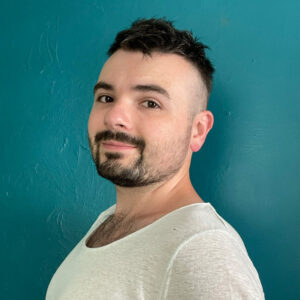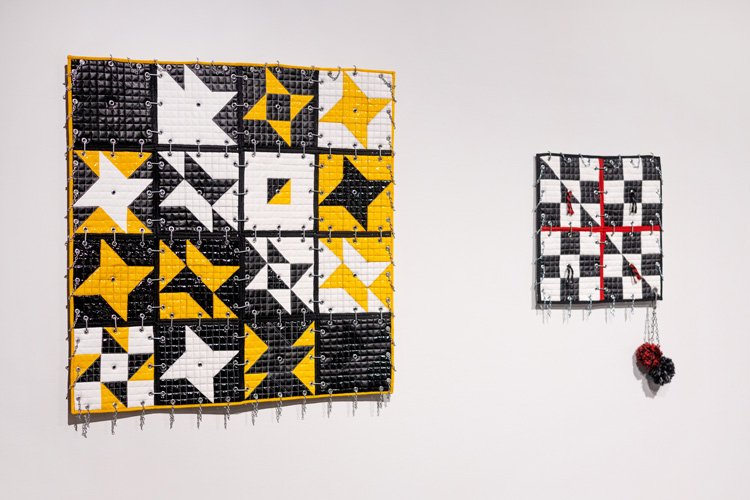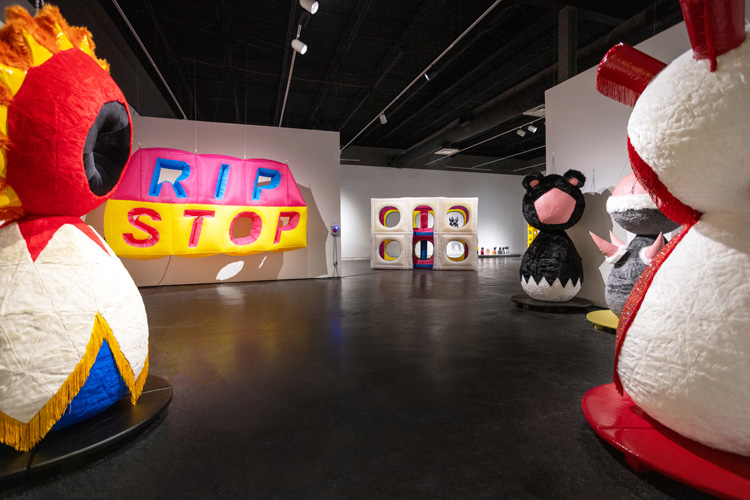Max Adrian’s new exhibit is a hopeful search for the future.

Fiber artist Max Adrian explores the ideas of queer identity and utopia in his solo exhibit RIPSTOP, currently on display at the Houston Center for Contemporary Craft (HCCC).
We spoke with Sarah Darro, curator and exhibitions director for HCCC, who worked with Adrian for more than a year mounting the show. She told us she was first attracted to the out artist because of his intricate, impeccable creations.
“I was attracted primarily by the rigorous craftsmanship and conceptual nature of the work. The work is so smart,” she says. “It’s about the constant state of becoming that’s involved in queer identity formation, how we’re constantly evolving, becoming ourselves, and always trying things on.”
RIPSTOP is a mid-career survey showing about a decade of work. Much of it is based on Adrian’s examination of José Esteban Muñoz’s book Cruising Utopia: The Then and There of Queer Futurity.

“This is a body of work about Max’s vision about what queer utopia could look like, so I think it is important that he’s bringing his own experience and identity to it,” says Darro. “The premise is that utopias are always on the horizon; you’re never quite there yet. There’s a perpetual forward motion, always moving toward something.”
Adrian, who uses the pronouns he and they, has a background in soft-sculptural, quilting, puppetry, drag, and fetish wear. While much of his work is overtly related to queer identity, it also explores other topics including climate change and performance.
“I don’t think this work needs to be presented in a specific framework about queerness,” Darro says. “At the same time, I think it brings a lot to the table when you include that. When we’re showing work about identity, it’s a really dynamic collaboration between a curator and an artist. I don’t think that the curator and the artist need to share the same background or preferences. My having a different background than the artist can sometimes bring out something interesting in a show. My being a good listener and asking the right questions is what helps to make a good show. Especially when we’re working on a solo exhibition, we work in a collaborative way and we don’t both have to have the same starting point.”
The exhibit includes several inflatable sculptures and patchwork quilt-like textiles. When visitors step into the gallery, motion sensors trigger airflow that fills the sculptures, causing them to grow and move.

“They inflate in front of the visitor and perform for them,” Darro says. “They stay on for a while and then they eventually wilt and fall.”
The sculptures seemingly engage with the viewer, interacting with them. “As soon as you walk in, you’re also on the stage. You’re performing, too. It’s really spectacular.”
Adrian also includes several fiber creations, some of which evoke the AIDS Memorial Quilt.
“There’s one quilt in the exhibition that’s made of pieces of underwear, hot pants, and donation elements from former lovers, and it’s called ‘Specimens of a Queer Quilt.’ I think those kinds of intimate details are important for his work and telling his story and his experience.”
Adrian and Darro very purposefully worked on the exhibit’s layout. “It’s important to consider how you want people to feel when they walk in. The first thing that happens when you walk into the show is that five 8-foot creatures perk up and move. That was a very intentional move. I think something really beautiful and interesting can happen. RIPSTOP, the title, was also really intentional. It’s like a double command, almost like a director telling you ‘Rip. Stop. Action. Cut.’ Max and I have been talking about what we hope people get out of this work,” Darro says.
“Everybody brings a different experience and perception to the show, of course. As a curator, I want people to engage with the art. I want people to stop and do a close look and have an experience that is different from the rest of their day, where they are constantly scrolling and being busy thinking about what’s next. The show [will hopefully] make people stop and think deeper or move slower, maybe. All of these works are incredibly alluring and they draw you in. We want you to be drawn in and inspired. We want to think about how you are performing identity every day, and how you are contributing to a more equitable, safer, more utopian space that we share. It’s a really hopeful show.”

